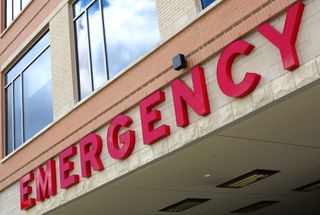ER visits declined during pandemic. But that wasn't a bad thing, study suggests.
Visits for appendicitis and miscarriage dropped during the pandemic, but that didn't translate into worse outcomes for patients.

During the COVID-19 pandemic, many people have avoided emergency room visits, but this isn't always a bad thing, a new study suggests.
The study, published Tuesday (May 25) in the Canadian Medical Association Journal, found that emergency room (ER) visits for appendicitis and miscarriage dropped markedly during the pandemic, but that didn't translate into worse outcomes for patients.
The authors say their findings suggest that people may have been overusing the ER before the pandemic, seeking hospital care for symptoms that could have been managed with telemedicine or outpatient treatment. But during the pandemic, those who really did need hospital care still received it.
Related: 20 of the worst epidemics and pandemics in history
"These findings are reassuring, as patients who required emergency care in the first wave of the pandemic continued to present to the emergency department, received similar care and had similar outcomes to patients presenting in the pre-pandemic period," the researchers, from St. Michael's Hospital in Toronto, Ontario, wrote in their study.
ER visit drop
During the first wave of the COVID-19 pandemic, doctors around the world noticed an interesting phenomenon: Visits for non-COVID-19 conditions mysteriously dropped. This led to concerns that patients weren't getting the care they needed for potentially life-threatening conditions.
In the new study, the researchers analyzed information on emergency room visits in Ontario, focusing on four conditions commonly seen in the ER: appendicitis, miscarriage, gallbladder inflammation (often due to gallstones) and ectopic pregnancy. The researchers pulled information from several population databases that collect health administrative data and information on ER visits and hospitalizations in Ontario.
Sign up for the Live Science daily newsletter now
Get the world’s most fascinating discoveries delivered straight to your inbox.
They then compared ER visits during a period prior to the pandemic, between January 2019 and July 2019, with ER visits shortly before and during the pandemic's first wave, from January 2020 to June 2020.
Overall, there were nearly 40,000 ER visits for these four conditions during the 2019 and 2020 periods combined, including nearly 16,000 visits for appendicitis, 12,733 visits for miscarriage, 8,457 visits for gallbladder inflammation and 2,537 visits for ectopic pregnancy.
Visits for all four conditions declined at the start of the pandemic in March 2020 compared to the 2019 period; however, visits for gallbladder inflammation and ectopic pregnancy soon returned to normal levels after a few weeks. In contrast, visits for appendicitis and miscarriage remained below expected levels, with vists for these conditions down by 20% to 39% per week from March 2020 to June 2020. That translates to 1,087 fewer visits for appendicitis and 984 fewer visits for miscarriage during the pandemic period.
But critically, the researchers did not find evidence that this drop in ER visits was harmful to patients. For example, there was no evidence that patients were sicker when they came in (because they delayed care) in 2020 versus 2019 — the researchers found there was no difference in the type of care patients needed, how long they stayed in the hospital or their overall rates of complications or death, in 2020 versus 2019.
ER overuse?
To explain this drop in ER visits, some researchers have suggested that people underutilized the ER because of fear of catching COVID-19, or that there may have been a true reduction in the occurrence of these conditions. However the new study suggests that in some cases, another factor may be at play.
"Our study suggests a third possibility: potential overusage of the emergency department before the pandemic," the authors said. "Avoidance of the emergency department during the pandemic may have resulted in miscarriages being managed through outpatient or virtual clinics without an emergency department visit. For some patients with mild symptoms of uncomplicated appendicitis, their symptoms may have resolved without presenting to the emergency department or they may have used virtual visits for conservative management."
The authors note their study had some limitations; for instance, the study included ER visits only in Ontario, and so it's unclear whether the same findings would be seen in other locations.
Another study published this month in the Journal of Pediatric Surgery examined pediatric visits for appendicitis at the New York-Presbyterian Morgan Stanley Children's Hospital (MSCH) before and during the pandemic. The researchers found patients who visited the ER for appendicitis in the spring of 2020 tended to wait longer before coming in and were more likely to experience more serious complications than those who visited in the spring of 2019. However, during the pandemic, many pediatric centers in the New York-Presbyterian hospital system redirected their pediatric patients to MSCH, and so the hospital actually received more patients with appendicitis during the pandemic than before; and the researchers could not compare total appendicitis visits before and during the pandemic.
In addition, for the Ontario study, the time period in the study may not have been long enough to capture all delayed presentations; although the researchers note that they followed patients who did come in for 30 days after their visit and did not find an increase in complications.
The authors of the Ontario study concluded that although it is important to seek emergency medical care when needed, the public should also be informed about alternatives to the emergency room, such as telemedicine or after-hours clinics that may help people determine the level of care they need.
Originally published on Live Science.

Rachael is a Live Science contributor, and was a former channel editor and senior writer for Live Science between 2010 and 2022. She has a master's degree in journalism from New York University's Science, Health and Environmental Reporting Program. She also holds a B.S. in molecular biology and an M.S. in biology from the University of California, San Diego. Her work has appeared in Scienceline, The Washington Post and Scientific American.